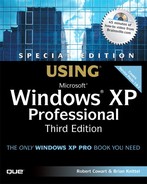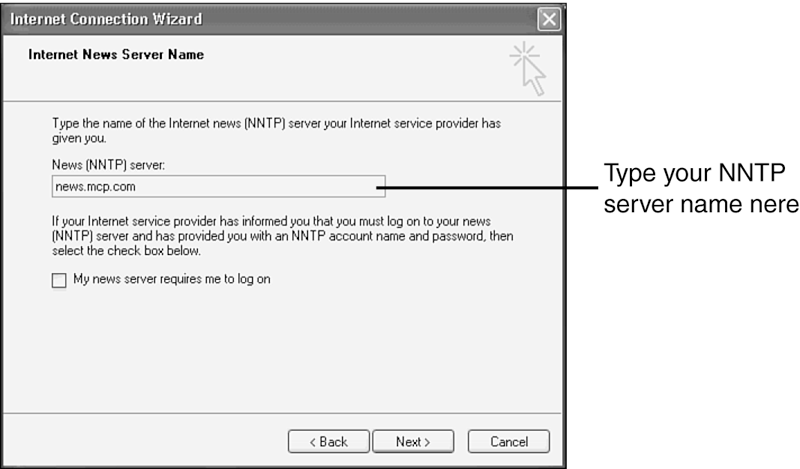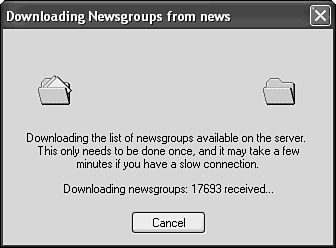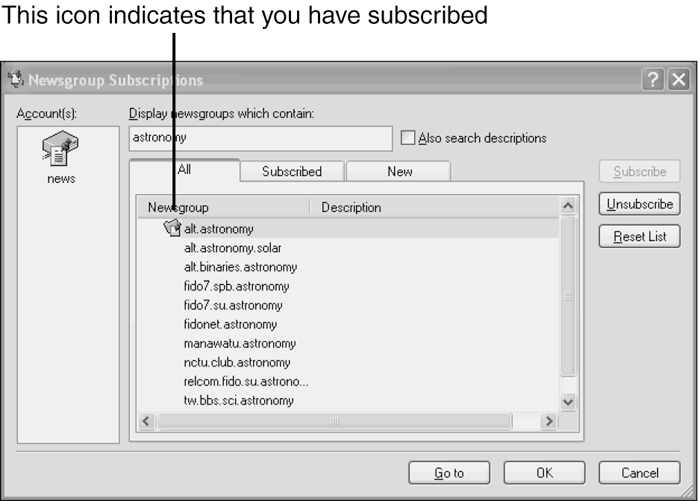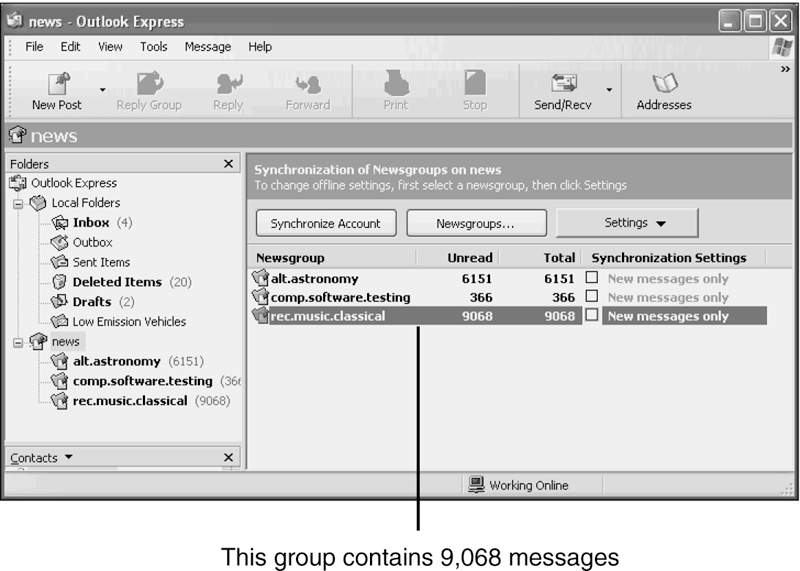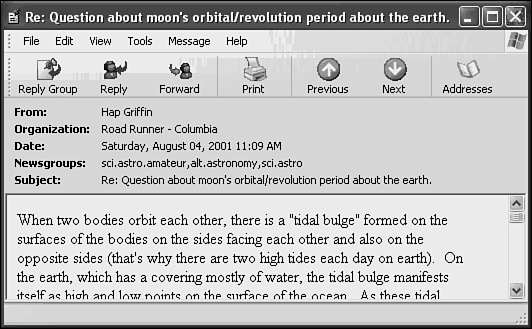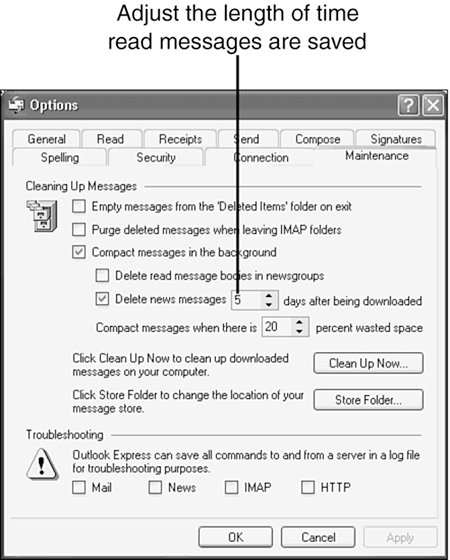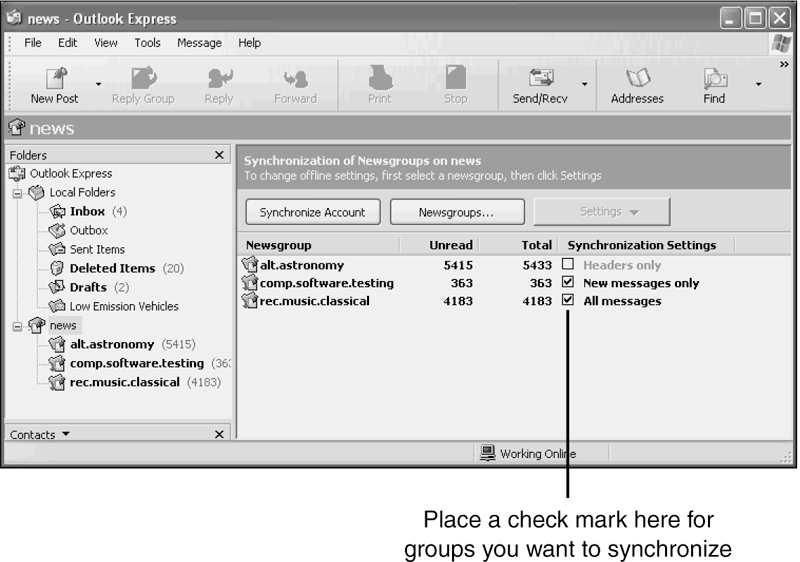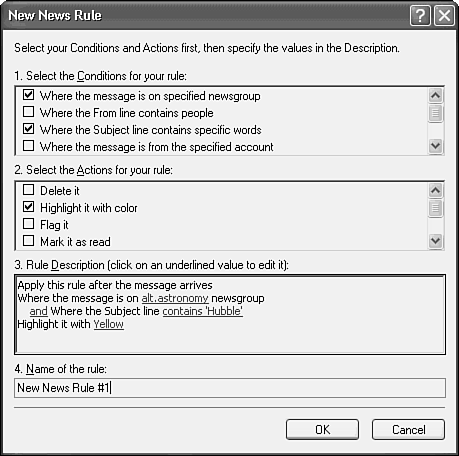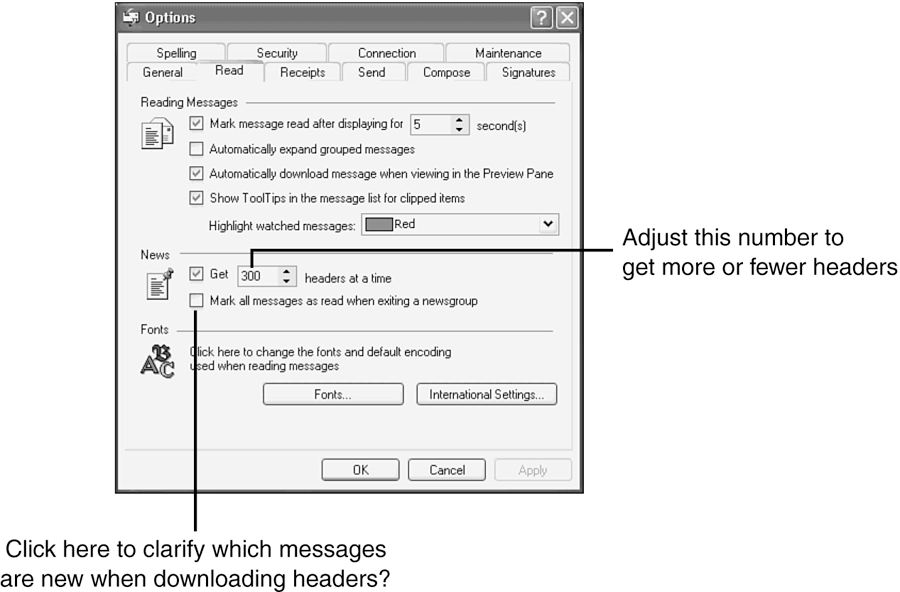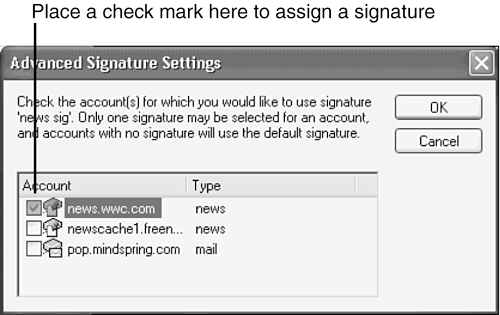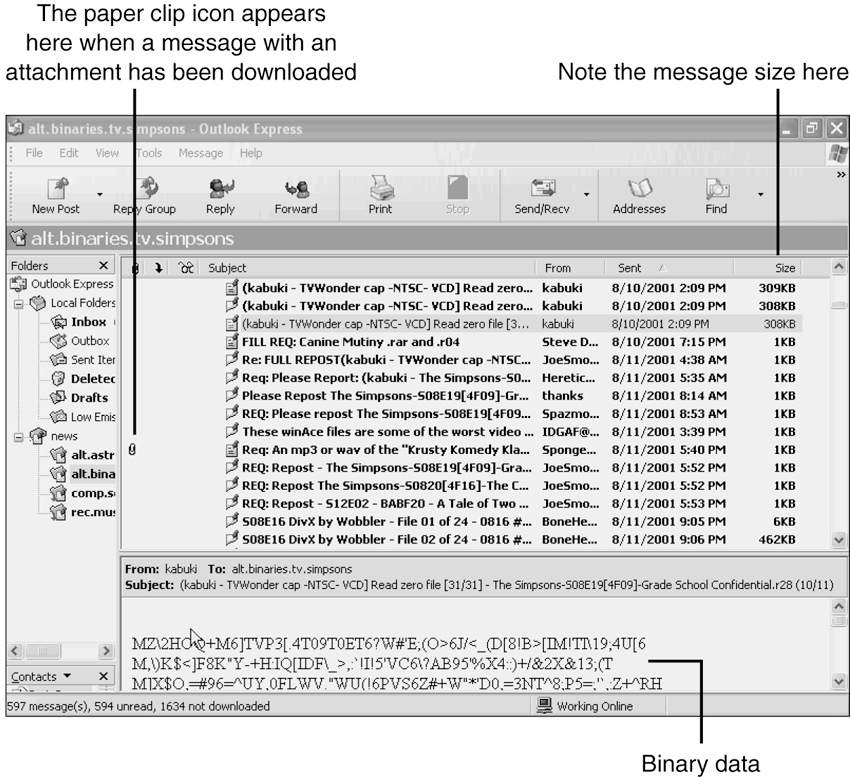In this chapter
With the overwhelming and still growing popularity of the World Wide Web since its inception in the early 1990s, you might easily forget that the Internet was around for more than two decades before the first Web page saw the light of a cathode ray tube. Before the inception of the Web, people used the Internet to access newsgroups. Newsgroups began in 1979 as a forum in which Unix users could communicate with each other, and the concept grew steadily from there into what is now a global assemblage of people sharing information on virtually every topic imaginable.
Originally, news servers exchanged articles using Unix-to-Unix Copy Protocol (UUCP), which involves direct modem dial-up over long-distance phone lines. In 1986, the Network News Transport Protocol (NNTP) was released, allowing news to be transported via TCP/IP connection over the Internet. Most modern newsgroups use the NNTP protocol, and it is the only news protocol supported by Outlook Express.
Newsgroups are scattered on servers around the world, and the rough network used to carry newsgroup bandwidth is generally referred to as Usenet. We're not implying, however, that some authority provides oversight of Usenet. “Usenet is not a democracy” is one of the first statements you will read in virtually any primer or Frequently Asked Questions list (FAQ) on the subject, alluding to the virtual anarchy in which this medium exists. Usenet has become so large and diverse that a simple definition cannot possibly do justice.
What we can do, however, is roughly describe the types of newsgroups and news servers that you can access using Outlook Express 6 (OE6). Basically, the administrator of your news server determines which news feeds you will have access to. Feeds are passed along to the server from adjacent servers, providing a decidedly decentralized structure to Usenet. Each server maintains a list of message IDs to ensure that new articles are received at a given server only once. An individual server can control which feeds it propagates, although the interconnectivity of Usenet servers ensures that a lone server has little or no control of the overall distribution. Thus, the authority of a news server is generally limited to what clients (that would be you) can access and what kind of material those clients can post. Likewise, the decentralization of servers means that an article you post may take hours—or even days—to circulate among all other news servers.
NOTE
The terms newsgroup and Usenet are used almost interchangeably in today's online world, but it is useful to know that newsgroup refers to individual groups, whereas Usenet refers to the entire network of groups as a whole.
Are newsgroups the same as mailing lists, or listservs, as some people call them? No. So here's a little digression about those, just to make the distinction. The very openness that makes newsgroups desirable has its drawbacks: privacy and security are almost nonexistent. Mailing list posts are less public because usually the only people who can read them are other list members, and lists are generally less susceptible to spam and objectionable material. Furthermore, mailing list traffic comes into your email reader (your inbox in OE), making lists easier to deal with for some people.
Mailing lists are simple; you send a message to the list address, which is then forwarded to every other list member. Every time another member posts a message to the list, you receive a copy. The list is managed by a list administrator who often, but not always, works directly with the mail server hosting the list. Often the administrator can be reached via the email address listproc or majordomo followed by @ and the name of the domain server.
Virtually any topic imaginable has a mailing list. If you want to find one to join, a good place to start would be CataList, available online at
http://www.lsoft.com/lists/listref.html
Lists vary widely in terms of message volume, ranging anywhere from only a few messages per month up to hundreds of posts each day. Many listslet you opt to receive one or two daily list compilations rather than a string of individual posts. These compilations are called digests and are especially useful with high-volume lists.
Before you join and start to participate in mailing lists, you need to keep two main issues in mind: security and netiquette. Security is largely determined by the list administrator, so you should check list policies for concerns before you join. You should also exercise caution when posting sensitive information to a list because, generally speaking, you won't know who is actually subscribed.
Netiquette is a little trickier. You've probably already read volumes on such topics as flame wars and the public airing of private laundry, but you should be aware of some issues unique to mailing lists:
Don't post attachments. Most mailing lists, especially those offering a Digest mode, forbid file attachments, and for good reason. If you want to send a file to someone, do it off list.
Send posts in plain text format. HTML formatting can wreak havoc on recipients' systems. Check with the list administrator to find out whether MIME or uuencode plain text formatting is best.
Read and save the FAQ. Every list has a different procedure for subscribing, unsubscribing, switching to digest mode, or changing various other options. This information is usually contained in a list FAQ, which should also include guidance regarding list content and rules.
Be conscious of the reply procedures for your list. Some mailing lists are configured so that a Reply action goes only to the original sender, and you must click Reply All to post a reply to the list. But with other lists, clicking Reply sends your response directly to the list. Again, double-check your list's FAQ to find out the correct procedure.
Do not use an “Out of Office” auto-reply rule for your Inbox. Automatic replies to incoming messages can cause destructive feedback loops in lists that you are subscribed to. (Since every incoming message from the list triggers a response from Outlook Express, those responses go back to the mailing list, generating more list traffic that will be sent to your account, resulting in more auto replies, and so on.) If you feel that you must use such a rule, unsubscribe or suspend your mailing lists before enabling it.
TIP
Because mailing lists can dump dozens—or even hundreds—of posts into your email account daily, set up a separate folder in OE for each mailing list, and use Message Rules to direct incoming messages to that folder. (For more on Rules, see Chapter 10, “Sending Email with Outlook Express.”)
Note
→ Spam is a fact of life in both mailing lists and newsgroups. To learn more about spam, see “Avoiding Spam,” p. 413.
Many ISPs and companies provide news server accounts to their Internet users, but you still might find yourself looking for a server on your own. This might be the case even if you have a news account available to you; some service providers censor the news content that is available, and if you want uncensored news, you must rely on a different source.
Many news servers are available through virtually any Internet connection, but you'll pay for that connection. Typically, monthly charges for a personal news server account range from $10 to $20 per month and get higher for corporate or higher bandwidth accounts. If you plan to use newsgroups frequently, you might want to factor in this cost when you're shopping for an ISP. You can find a good list of commercial news servers at
http://freenews.maxbaud.net/forfee.html
However, if you have an Internet connection and would simply like a different news server, you can find a list of free news servers available online: the list of free servers can change daily.
http://freenews.maxbaud.net/newspage.html?date=today
A free alternative to commercial news servers is a Web-based news service, such as the one created by deja.com. An advantage of using a Web-based news service is that a search brings back results from many newsgroups, not only one. It's a terrific way to find expert postings on just about anything from open-heart surgery, to child adoption, to what people think of the new car you're considering buying. However, messages are not brought into your news client program (such as OE) for reference offline. Deja was bought out and redesigned by Google awhile back, so until recently, you couldn't post new messages to Usenet, but now you can again. Just go to http://www.google.com and click the “Groups” link. Web-based news server at the time of this writing could be found at http://newsguy.com/news.asp.
Outlook Express 6 (OE6) is included free with XP and serves quite well as a news reader. If you already use OE6 for email services, you're probably already familiar with the basics of using this program. If not, you may benefit from a quick review of Chapter 10, “Sending Email with Outlook Express,” which will help you master the fundamentals of using OE6.
You first must set up a news account in OE6. You might do so at the same time you set up an email account, but if not, you can configure it any time. Before you can configure your news account, you need to obtain a news server address, which should look something like this:
news.domainname.com
Your company might also have a news server account with a commercial provider. You can configure multiple server accounts in OE6, just as you can set up multiple email accounts.
As mentioned earlier, a news server provides you with news feeds from other news servers. Which feeds are available to you depends on decisions made by your server's administrator. For example, some news servers restrict feeds for all alt. (alternative) newsgroups because some of them contain highly objectionable material.
Note
→ If you do not have a news server you can access, see “Locating News Servers,” p. 402.
To set up your account in Outlook Express, follow these steps:
Open Outlook Express, and choose Tools, Accounts to open the Internet Accounts dialog. Click the News tab to bring it to the front, and then select Add, News.
Follow the instructions in the Internet Connection Wizard for inputting your display name and email address (the wizard may provide this information for you).
Type the name of your news (NNTP) server, as shown in Figure 11.1.
Click Next, and then click Finish.
After you have configured Outlook Express for your news server, your next step is to download a list of newsgroups from the server. Depending on how many groups the server allows access to, this list could contain more than 75,000 newsgroups. In reality, most servers list less than half that number.
Why aren't they all listed? As you've already seen, some content might be censored by the server's administrator. In many cases, though, it is a much more practical matter: New groups are created so frequently that your server simply might not be aware of them. If you become aware of a newsgroup you would like to join, but it is not currently available on your server, try dropping an email message to the administrator and ask for the group to be added. Assuming the group falls within the administrator's guidelines for acceptable content, adding the group will take only a few seconds.
To begin downloading your server's list, follow these steps:
Click the listing for your news account in the OE6 Folders list.
A message appears stating that you are not currently subscribed to any newsgroups and asking whether you would like to view the list. Click Yes.
If this is the first time you have viewed the list, a dialog appears, as shown in Figure 11.2. Depending on the size of the list and the speed of your connection, downloading could take several minutes. You probably have time to go get another cup of coffee. When the process is finished, the list is downloaded, and you are ready to locate and subscribe to newsgroups.
Usually, when you read a newsgroup, you must first subscribe to it. A subscription simply means you've placed a bookmark of sorts in Outlook Express for that group, making it easy to return to and follow conversations whenever you are using OE6.
Before you can subscribe to a newsgroup, you need to find one that piques your interest. Searching for a group in your downloaded list is fairly simple in OE6 (see Figure 11.3). If the list isn't already open, you can open it by clicking your news account in the Folders list. If the list doesn't open automatically, you can click the Newsgroups button on the toolbar.
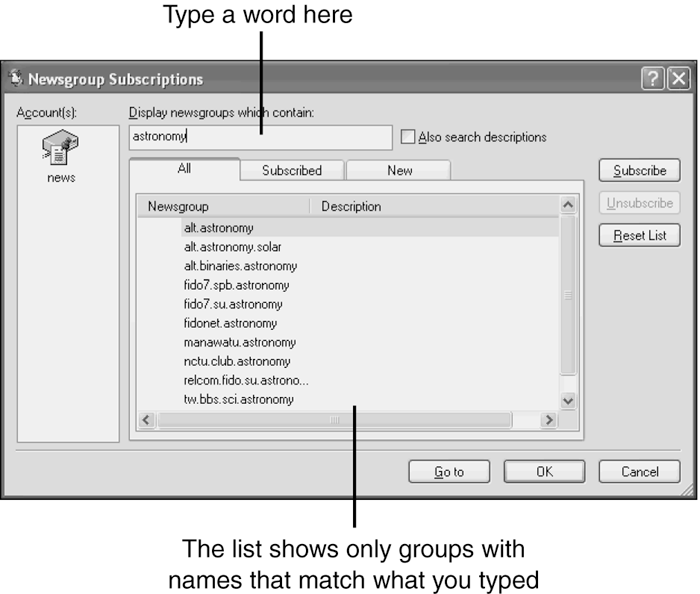
Figure 11.3. You can begin typing a word to search the newsgroup list. The list automatically gets smaller as you type, showing only those groups with names that match what you typed.
As you type a word in the Display Newsgroups Which Contain field (Figure 11.3), the list of newsgroups shrinks. You can experiment by typing a keyword you are interested in, pausing after each keystroke.
Newsgroups are usually—but not always—named descriptively. In Figure 11.3, you can see the option to search newsgroup descriptions as well as their names, but very few groups actually have descriptions listed in this window.
TIP
If you don't find a newsgroup that interests you, try a search at http://groups.google.com/ or another Web source to see whether other groups not currently available on your news server exist. There is no such thing as a “complete” list of newsgroups, so a search of several different resources will yield the best results.
OE6 does not require you to subscribe to a group to view its contents. You can simply select a group from the list and click Go To to see messages posted to the group, but you might find it easier to manage the process by simply subscribing anyway. Subscribing to a newsgroup does not require any great level of commitment on your part because you can always unsubscribe with just two mouse clicks.
When you find a newsgroup you want to subscribe to, do the following:
Click once on the newsgroup name to select it, and then click the Subscribe button. An icon should appear next to the group name, as shown in Figure 11.4.
Click Go To at the bottom of the Newsgroup Subscriptions window. The window closes, and the 300 most recent posts are downloaded to your computer.
Actually, only the message headers are downloaded, and they appear listed in the OE6 window. The message contents are not downloaded until you choose to view a specific message.
Newsgroups you are subscribed to are listed in the OE6 Folders list, under the news account listing, as shown in Figure 11.5. If you have multiple news server accounts, individual subscriptions are listed as subfolders under the server you used to subscribe to them.
When you click a newsgroup's listing in the Folders list, the 300 most recent headers are downloaded.
Note
→ If you want to change the number of headers shown, see “Customizing Outlook Express for Newsgroups,” p. 415.
If you decide that you don't want to remain subscribed to a group, unsubscribing is easy. Just right-click the group's listing in the Folders list, and choose Unsubscribe from the shortcut menu that appears.
As you learned previously, when you first access a newsgroup using OE6, only the first 300 message headers are downloaded. You can download additional headers by clicking Tools, Get Next 300 Headers.
If you want to read a message, you need to manually open it. If you are using the Preview Pane, all you have to do is click once on the message header to cause it to download. If you are not using the Preview Pane, you can double-click a message to open it in a separate message window.
Note
→ To learn how to show or hide the Preview Pane, see “Outlook Express Quick Tour,” p. 362.
As you peruse the list of messages in the group, you need to understand the concept of discussion threads. A thread occurs when someone responds to a message. Others respond to the response, and this conversation becomes its own discussion thread. Messages that are part of a thread have a plus (+) sign next to them, and you can click this icon to expand a list of other messages in the thread. Figure 11.6 shows several expanded threads.
Posting messages to a newsgroup is quite simple. Perhaps the easiest way to post is to reply to an existing message. This process works much the same as replying to regular email, except that you must take extra care to ensure that your reply is going to the right place. Notice that the toolbar has a new button—the Reply Group button—as shown in Figure 11.7.
Each reply button serves a unique purpose:
Reply Group | Sends a reply back to the group |
Reply | Sends a reply only to the original sender |
Forward | Forwards the message to a third party |
One aspect to watch carefully is that messages you post to a newsgroup are relevant. If the newsgroup is moderated, someone reviews all posts and removes those posts that are deemed inappropriate. Look for a newsgroup FAQ (Frequently Asked Questions) for more information on netiquette and any rules that might apply to the groups you are subscribed to.
By default, OE6 deletes messages from your computer five days after you download them, but you can change this option easily. Likewise, you can also set up Outlook Express to delete read messages every time you leave the group. You can review these settings by choosing Tools, Options. In the Options dialog, click the Maintenance tab to bring it to the front, as shown in Figure 11.8.
Note
If you're not sure which messages have been read and which haven't, see “Which Ones Are New?” in the “Troubleshooting” section at the end of the chapter.
If you want to maintain a record of the messages in your newsgroup, remove the check marks next to each Delete option shown in Figure 11.8. Messages remain in OE6 indefinitely if you deselect both of these options, but keep in mind that if the group has high traffic, these messages could eventually eat up a lot of disk space.
The better option is to save individual messages that you want to maintain. To do so, create a new folder for storing news messages under Local Folders in the OE6 Folders list, and then drag any messages you want to save into the folder. You can also drag and drop newsgroup messages to any of your email folders, but you might find it easier to keep newsgroup and email correspondence separate.
In Chapter 9, “Browsing the World Wide Web with Internet Explorer,” you learned that you can download Web pages for offline viewing. You can do the same with newsgroup messages, a capability that makes especially good sense if you must limit your Internet connection time or will be traveling with your laptop. OE6 calls this feature synchronizing.
CAUTION
Before you synchronize a newsgroup for offline viewing, check the size of the messages you will download. Some people post pictures and other large files into newsgroups, and they can add significantly to download time.
To begin downloading a newsgroup for offline viewing, click your news server account in the Folders list. A list of the groups you are subscribed to then appears, as shown in Figure 11.9. Now follow these steps:
Select the newsgroup(s) you want to synchronize, and review the synchronization settings. By default, only new messages will be synchronized, but you can change this setting by clicking the Settings button and choosing another option.
Place a check mark in the box(es) under Synchronization settings, as shown in Figure 11.9.
Click Synchronize Account. Messages are downloaded based on the synchronization settings you choose. Keep in mind that if you choose to synchronize all messages, the download could take awhile.
When the download is complete, you can get offline to read the downloaded messages. If you try to open a message that isn't available offline, a warning advises you of this fact.
You also can select individual messages for offline reading. Choosing particular messages may be a better course of action, especially if the newsgroup has thousands of messages and you want to download only the first few. Select several message headers in the newsgroup by Ctrl+clicking or Shift+clicking. Then right-click the selection and choose Download Message Later from the menu that appears. When you later choose Synchronize Account from the server account window shown in Figure 11.9, only the selected messages are downloaded. Note that if you select to download all messages in your synchronization settings, all messages will be downloaded, not only the ones you selected.
It's no secret that many potential hazards exist in the online world, and nowhere is this more evident than in Usenet. Objectionable Web pages get all the media attention, but nowhere is objectionable—and often illegal—content more readily available than in newsgroups. You can avoid most objectionable content simply by staying away from certain newsgroups, but you might still find the need to filter some of the content you receive.
Besides objectionable content, you must also consider that you become more vulnerable to victimization (or, for that matter, prosecution) when you participate in newsgroups unless you take some basic precautions. Remember, anyone in the world who has access to an Internet connection can see what you post in a newsgroup.
OE6 enables you to set up some message rules to filter certain messages. You can set up this feature, which is similar to mail message rules, as follows:
In Outlook Express, choose Tools, Message Rules, News.
In the New News Rule dialog, choose conditions for your rule in box 1. As you can see in Figure 11.10, you can select more than one condition. In this case, we're looking for messages in the
alt.astronomynewsgroup that contain the word Hubble in the subject line.In box 2, choose what you want to happen to messages that meet your conditions. In this case, matching messages will be highlighted in yellow. If the condition were looking for objectionable material, we would probably choose to delete it instead.
In box 3, review the rule description and enter any required information. For example, you will probably have to specify words or other pieces of information pertaining to the conditions you set.
Click OK when you're finished, and click OK in the Message Rules dialog to close it.
You can modify or disable a rule at any time by using the Tools, Message Rules, News command.
Note
→ You can also filter news by restricting senders. To learn how, see “Filtering Your Mail,” p. 386.
Besides objectionable content, the other great hazard involved with using newsgroups is the threat to your identity and personal information. You can avoid having personal information compromised on Usenet by simply not posting it. Don't post your home address or phone number, age (especially if you are young), or financial information (such as a credit card number).
You also can hide your identity if you do not want to reveal it. Outlook Express identifies you in all outgoing posts by whatever username you entered when you configured the account. If you are concerned about protecting your identity in newsgroups, consider changing the username for your news account to a nickname that your friends or associates will recognize but strangers won't. Figure 11.11, in the next section, shows such a nickname in use.
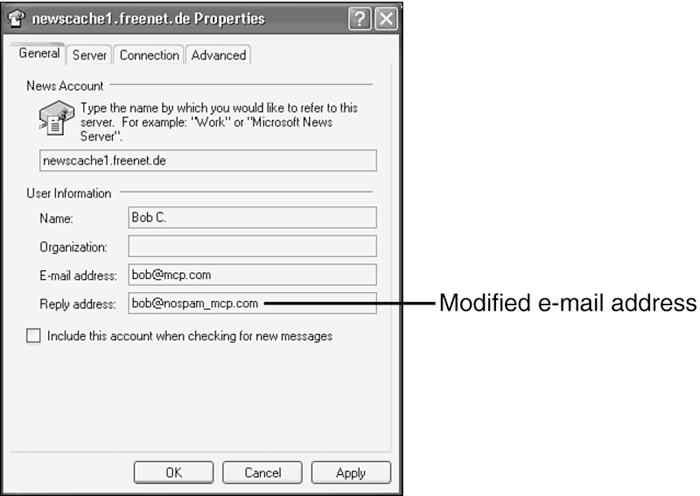
Figure 11.11. You can type a modified identity and reply address in this dialog to avoid spam and protect your identity somewhat in Usenet.
Of course, there are limits to how much anonymity can be provided by simply changing the username and email address for your news account in OE6. Any message you post to a newsgroup can be easily traced back to your server, and your server maintains transaction logs that allow your real identity to be ascertained.
A better way to protect your identity is by signing up for a Web-based email account, such as those available at Yahoo! or Hotmail, and register for a rather bland address. When you do this, limit the amount of information that you give.
Using a pseudonymous remailer can be an even more secure solution. A pseudonymous remailer is a server that assigns you an ID based on a proprietary scheme, and you send and receive through the server. However, finding a remailer may be challenging because of their tendency to have a short lifespan, perhaps because of their low profitability. Also, some remailers require you to use a specific news application, and it never seems to be OE.
At the time of this printing, it was possible to find a list of pseudonymous remailers, and FAQs, online at the following site:
http://www.andrebacard.com/remail.html
Some remailer choices include: www.ziplip.com, www.securenym.net, and www.hushmail.com.
One of the most pervasive threats to your identity that exists in Usenet is spam (see “Dealing with Spam” in Chapter 10 for more information).
Programs called spambots do nothing but scan Usenet message headers for email addresses. These addresses are compiled and sold to companies that send out unsolicited advertisements via email. If you post frequently to newsgroups, your email address could get “vacuumed” in this manner, resulting in a greater volume of spam in your Inbox.
Fortunately, spambots aren't intelligent, so defeating them is relatively simple. The most common tactic is to add a word to your email address that actual human beings will recognize as an anti-spam measure. It would look something like this:
bob@nospam_mcp.com
A person who wants to respond to you can easily remove the “nospam_” from your email address, but most spambots won't be able to recognize it, and the spam that was meant for you will end up bouncing back to the sender. There are rumors that some spambots might have become savvy to this technique, and can remove text such as “nospam” from an email address. You might want to try another approach, if you find that nospam isn't working. Use something odd such as
In your postings, you can say “to respond to me, just remove myhat and use the remaining address.”
You can change your reply address by clicking Tools, Accounts to open the Internet Accounts dialog. Then click the News tab, select your news account, and click Properties. Type the modified email address in the Reply Address text box, as shown in Figure 11.11, and click OK to close the dialog.
You're not the only person trying to remain anonymous in Usenet. Trying to respond to a message you read can cause you a few problems, especially if you are trying to respond directly to the poster.
Obviously, there are different levels of anonymity. If the person is simply using a nickname, you should be able to respond to him or her normally. But if that person is also trying to conceal his or her email address, responding can get trickier. If an error message is returned to you when you try to send someone email (often called a bounce), check that person's email address to see whether he or she is using an anti-spam scheme as shown here:
bob@nospam_mcp.com
People who use this naming scheme usually have something in their signature files that says “To reply, remove 'nospam_' from the domain” or something to that effect.
If the email address is obviously not valid, and no clues to the individual's real address exist, your last resort may be to post to the newsgroup. But don't use this situation as an excuse to share a private response in a public forum. A typical response would look something like this:
Attn: bob@nospam_mcp.com I wish to send you a response. Please contact me directly at [email protected].
This message should get the individual's attention. If not, there's not much else you can do.
Outlook Express 6 comes with a fairly good package of preset options for reading and participating in newsgroups. Still, what works for the “average” user might not suit you. You can customize virtually every aspect of news reading in this program by reviewing the various settings available to you. To do so, follow these steps:
In OE6, choose Tools, Options.
Click the General tab to bring it to the front, and then remove the check mark next to Notify Me If There Are Any New Newsgroups if you already plan to reset your group list periodically without input from OE6.
Click the Read tab, as shown in Figure 11.12. OE6 automatically downloads the first 300 headers at a time, but you can change that number here. You also might want to check the option Mark All Messages as Read When Exiting a Newsgroup. If you routinely ignore some posts in the group, selecting this option will help you determine which messages are actually new the next time you open the group.
Switch to the Send tab to make your default news-sending format HTML if you like, but doing so is not recommended because most news readers can't read HTML formatting.
Click the Signatures tab to bring it to the front, and create a new signature to be used exclusively with newsgroups. Your news signature could include instructions for removing anti-spam measures from your email address. After you have created the new signature, click the Advanced button to open the dialog shown in Figure 11.13. Here, you can select your news account to “assign” the signature to it. After you have assigned a signature, it will be used only with that account.
On the Maintenance tab, check the two news-related Delete options if you want to save disk space.
Note
→ To learn more about setting the Delete options, see “Managing Messages,” p. 409.
Click OK to close the dialog and save your settings changes.
A newsgroup I want to access isn't available on my server.
Click Reset List in the Newsgroup Subscriptions window. The newsgroup may be new and simply not shown in your current list. If the group still isn't there, try contacting the ISP or other service that hosts the list and ask that service to add it. Often new groups simply go unnoticed because so many of them are out there. Many news servers are willing to respond to such a request, unless they have a rule restricting or censoring the particular group.
Try paying for an alternative dedicated news server that does carry the newsgroup you're interested in.
I tried to synchronize the group, but some messages I click aren't available.
Obviously, you should first check that the settings for the group are correct. If the group isn't set to All Messages, and the Synchronize check box isn't checked, this could easily explain the missing message bodies. Another possibility is that the message was removed from the host server sometime after the header list was distributed. It can take up to 72 hours after a message is physically removed before it disappears from the header list.
News servers only have so much disk space. To allow them to continually add incoming files to their lists, they must continually discard old files. If your server is missing a few articles you may “ask” for a repost of the incomplete files, but while the poster is expected to service reasonable repost requests there is no requirement to do so. Sometimes a regular poster might not service repost requests at all, but will instead indicate an FTP, ICQ, or IRQ service where you can pick up missing files. And in many cases a repost request will be answered by a person who just happens to have downloaded the same file set and is willing to help support the group.
Finally, if you are doing everything right and your server is not gathering all the articles that were posted, consider informing your ISP's support desk of the problem. It does not do any good to complain to everyone else in the newsgroup if you are not telling the few people who are actually paid to help you. Servers and the connecting routers are sensitive electronic equipment and their only guarantee is that they will fail at some point. Help your ISP monitor the network.
If your server is very poorly connected and misses a lot of articles, as I stated above, you should consider hiring a dedicated news service as a secondary server.
A message I read earlier is no longer available.
The default settings in Outlook Express delete read messages five days after you have downloaded them. You can change this option on the Maintenance tab of the OE Options dialog.
I can't tell which messages are new.
Open the Options dialog by choosing Tools, Options. On the Read tab, place a check mark next to Mark All Messages as Read When Exiting a Newsgroup.
Outlook Express cannot locate my news server.
Do you need to use a separate Internet connection to access the news server? If so, choose Tools, Accounts, and then click the News tab in the Internet Accounts dialog. Look at what is listed under Connection next to your news account listing. If it says Any Available, click Properties and select the Connection tab. Place a check mark next to Always Connect to This Account Using, and select the appropriate connection from the drop-down list.
Newsgroups began innocently enough as forums for university, government, and science research folks to find and offer various kinds of support and share info over the precursor to the Net. However, it didn't take long for Usenet to explode as a means of online recreation. Today, no matter how obscure you think your hobby or personal interest may be, a newsgroup is probably already dedicated to it. And one of the great advantages of newsgroups is the fact that files can be easily attached to posts. Attachments can be in the form of pictures, sound files, movies, text documents, programs, or anything else imaginable. In this respect, newsgroups really shine when compared to mailing lists; most mailing lists strictly forbid attachments, but in Usenet they are welcome.
Newsgroups with the word binaries in their address are good places to find attachments. The word Binary refers to a non-text attachment, some kind of a data or program file. Naturally, you need to exercise some care before you download any messages with large attachments. First, ask yourself whether you have enough bandwidth to download the message. The OE6 message list doesn't show a paper clip icon until you've downloaded a message with an attachment, but it does tell you the size of each individual message, as shown in Figure 11.14. It is a fair assumption that a large file size would indicate the presence of an attachment.
After you have determined that you can handle the message download, you should also keep virus safety in mind. If the attachment is a standard multimedia format, such as JPEG, WAV, GIF, MP3, or AVI, it should be safe. But if the attachment is an unknown format or is an executable program (.EXE and .VBS are common extensions for these), you should follow your standard anti-virus procedures.
Large news attachments are posted as multi-part files, to get around the message-size limitations of news servers. These postings break up the large attachment over several consecutive posts. You can usually identify these types of posts by the Subject field, which identifies the message as part of a series. For example, you might see something like, “xfiles.avi (1/3), xfiles.avi (2/3)…,” and so on.
Multi-part attachments only open properly if downloaded and then combined together. Your first step is to identify each part of the series; if you miss even one portion of the series, it will not open properly. Use Ctrl+click and/or Shift+click to select each member of the series. After you've selected all of them, right-click the series, and choose Combine and Decode from the shortcut menu, as shown in Figure 11.15.
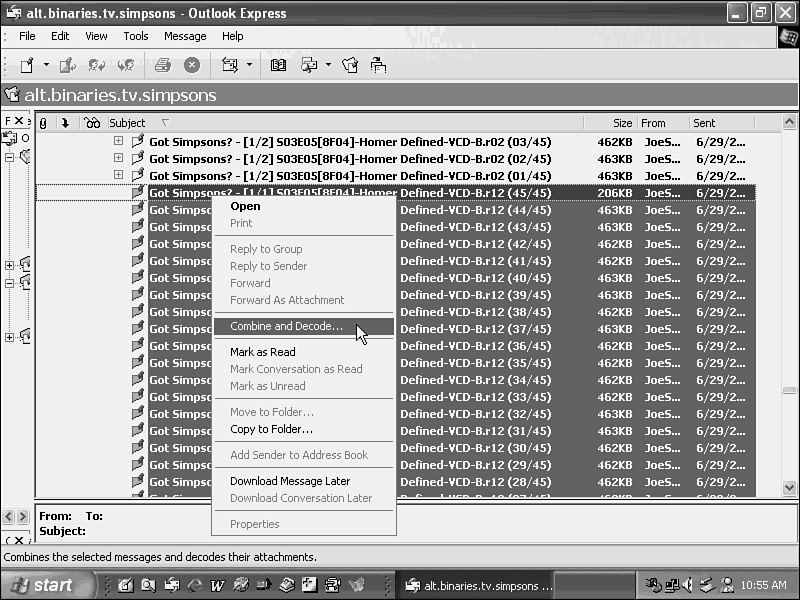
Figure 11.15. You must be sure you select every member of a multipart attachment series before attempting the download.
You are next presented with a dialog box asking you to put the series members in order. They should be in numeric order, starting with part one at the top of the list. Use the Move Up and Move Down buttons to place them in the correct order. Depending on the size of the multipart attachment, the download may take some time. When it is complete, a message window opens with a single attachment listed. This doesn't make much sense, since it looks as though you're going to send the file to someone. But typically you want to save it to your hard disk. So just right-click on that file icon in the attachment line, and choose Save As. Then save the file with the name and location you wish.
Multimedia attachments in Usenet can be a lot of fun. For example, the group alt.binaries.tv.simpsons usually contains WAV and AVI files of popular sound bites and catchphrases—or even an entire episode—from the television series The Simpsons. If you save downloaded WAV files in the WINNTMedia folder of your hard drive, you can later assign those sounds to various Windows events. Wouldn't Windows be more enjoyable if each critical stop were accompanied by Bart Simpson's “Aye Carumba” rather than the monotonous Chord.wav?
Another gem to be on the lookout for in Usenet is MP3 music. MP3 files offer CD-quality music, but because they use about one-twelfth the storage space, they can be transported efficiently over the Internet. You probably know about MP3s from all the hoopla about MP3 players such as the iPod and the old Napster court case, but you may not have known that MP3s were also available over newsgroups. Look for any newsgroup with mp3 in the address, but watch out for those bootlegs!
If you become a serious newsgroup junkie, especially if you're into downloading (or uploading) large files, you'll have some boning up to do:
Check out the news stuff at groups.google.com (formerly Deja.com) and correspond with heavy news posters on your group of choice. When you post large files, split them up into smaller chunks. In OE, choose Tools, Accounts. Click the News tab and Choose the news server you use. Click Properties, and the Advanced tab. Notice the setting there for Posting: Break Apart Messages Larger Than KB. This specifies to break up large messages, so that each part is smaller than the file size indicated. Some older servers cannot handle messages larger than 64 KB. By breaking large messages into smaller messages, you ensure that the messages are transmitted and received correctly. Make sure this option is selected.
Second, if you are seriously into newsgroups, you'll want to bag OE and use it only for your email. Download and get familiar with one of the serious programs designed for news, such as Xnews (download.com), News Rover (download.com), or Agent (forteinc.com/agent/index.php). Among other benefits, these specialized products automate the process of finding, grouping, downloading, and decoding file attachments split across multiple messages. They are serious time savers. Here's a list of URLs for a couple other alternative newsreaders:
NewsRover ($)
Newsbin Pro ($) and “classic” Newsbin (free)
Figure 11.16 shows an example of Xnews.
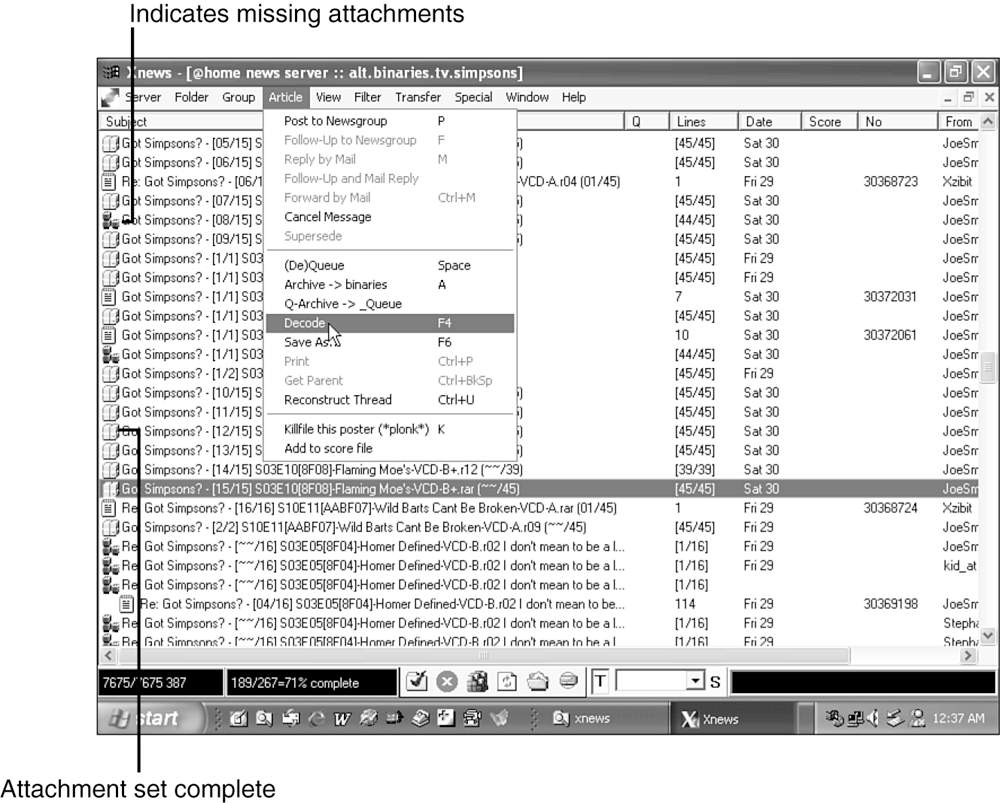
Figure 11.16. Xnews makes downloading, combining, and decoding multi-part news messages far less laborious than OE does.
NOTE
Some news readers, such as Agent-MP3, are specifically made to search Usenet and quickly find all the MP3 files.
Notice how the icons on the left indicate whether all the portions of a message are on the server. If the block icon is full, all the pieces of an attachment are present, and you can begin downloading. If not, skip it, and try to find it on another news server, or ask the poster to repost that portion. This saves you from having to visually examine and count to be sure all the attachments are there. Also, assuming the postings are named correctly, Xnews doesn't require you to rearrange them before downloading and decoding. It does so automagically.
